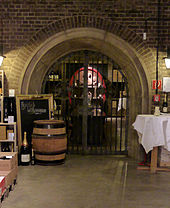Cologne wine cellar
The Cologne-based wine cellar is one of Cornelius Stüssgen 1937 at the Stolberg Street in new headquarters in Cologne-Braunsfeld erected barrel cellar , were stored in the wines for the company's own brands and bottled. After the Rewe Group took over the Stüssgen stores in Cologne in 1984 and the company headquarters closed, wine bottling was also discontinued. Today, the cellar, with some of the original furnishings, serves as the Rewe Group's specialist wine store.
History and architecture
In 1937 the wine cellar was built by Cornelius Stüssgen by building a cellar under the company headquarters in Cologne-Braunsfeld. The renovation work for the company headquarters built in 1928/29 was carried out by Walter Dißmann , who was already involved in the construction. For this purpose, the basement structure was created using a shaft construction . Stüssgen's idea arose from the desire for a good barrel cellar with constant temperatures and a high-quality bottling system to supply the branches of his retail company with wine. The path to the cellar leads over 51 steps down to a depth of 13 meters.
The basic construction is a solid concrete construction, which is lined with special bricks and into which a self-supporting vault was drawn. This construction ensures perfect humidity for wine storage and low temperatures, so the mark of 18 degrees is not exceeded even in hot summers. No artificial air conditioning is necessary for this.
At 95 meters long and 26 meters wide, evidence of the wine history of the cellar can still be found today: the old enamelled tanks have been completely preserved. Only a few of the large wooden barrels that were used to store the wine have survived. You can also see some pipelines and electrical systems from the founding years. One of the oldest operating elevators in Cologne, which also dates from 1937, leads into the basement . At the end of the east side of the cellar is the so-called “treasure chamber” with an old wrought iron gate, made by August Kotthoff . In the treasure trove of top wines there is also a barrel that the sculptor Ewald Mataré designed in 1947 as a commission for the 50th anniversary of the Stüssgen markets. It shows God the Father as well as Adam and Eve entwined with vines and bears the inscription "God gave us the wine for joy". Stüssgen stored special wines here, and rarities are still safely stored here today.
During the Second World War , the cellar served the residents of Cologne-Braunsfeld as an air raid shelter . In the 1980s, the Stüssgen stores went to the REWE Group. In the course of this, the wine bottling in the cellar in the Stolberger Straße was stopped and REWE opened a specialist wine shop at this point in the mid-1970s. The cellar was renovated in 1992 and is now used as a specialist shop, especially for wines in the higher price range.
Todays use
The name given to today's wine shop originated from the language used in Cologne, where the term "Cologne -" or "Stüssgen wine cellar" has always been mentioned. Today the wine cellar is an "outstanding technical monument " and is one of the largest historical wine cellars in Germany, in which over 2500 square meters over 150,000 bottles are stored today. The wine store has received numerous awards in recent years. In addition to sales and advice, the historic vault is used as a venue for events and trade fairs.
Award
- 2011: Wine Dealer of the Year in the "Specialist Wine Retail" category; Wine economy
- 2012: Wine Merchant of the Year; The gourmet
- 2015: Specialist trade award, German Wine Institute, third place
Individual evidence
- ^ Alfred Dissmann: A warehouse and office building in Cologne . Bauwelt, Volume 29, 1938, pp. 1–3
- ↑ Wolfram Hagspiel : Karger reconstruction and economic miracle architecture . In: Max Leo Schwering: Cologne. Braunsfeld Melaten . (= Publications of the Cologne City Museum, Volume 6.) Cologne 2004, ISBN 3-927396-93-1 , p. 315.
- ^ Ulrich Soénius : Industry, trade, services and technology in northern Braunsfeld . In: Max Leo Schwering: Cologne. Braunsfeld Melaten . (= Publications of the Cologne City Museum, Volume 6.) Cologne 2004, ISBN 3-927396-93-1 , pp. 459f.
- ↑ koelner-weinkeller.de: Weinkeller Historie , accessed on April 13, 2015
- ↑ foodhunter.de Kölner Weinkeller ( Memento of the original from April 13, 2015 in the Internet Archive ) Info: The archive link was inserted automatically and has not yet been checked. Please check the original and archive link according to the instructions and then remove this notice. , accessed April 13, 2015
- ↑ Wolfram Hagspiel: Karger reconstruction and economic miracle architecture . In: Max Leo Schwering: Cologne. Braunsfeld Melaten . (= Publications of the Cologne City Museum, Volume 6.) Cologne 2004, ISBN 3-927396-93-1 , p. 315.
- ^ Alfred Dissmann: A warehouse and office building in Cologne . Monthly booklets for architecture and urban development, year 22, 1938, pp. 337–339
- ^ Ulrich Soénius: Industry, trade, services and technology in northern Braunsfeld . In: Max Leo Schwering: Cologne. Braunsfeld Melaten . (= Publications of the Cologne City Museum, Volume 6.) Cologne 2004, ISBN 3-927396-93-1 , p. 460
- ↑ Wolfram Hagspiel: Karger reconstruction and economic miracle architecture . In: Max Leo Schwering: Cologne. Braunsfeld Melaten . (= Publications of the Cologne City Museum, Volume 6.) Cologne 2004, ISBN 3-927396-93-1 , p. 315.
- ↑ prinz.de: Kölner Locations: Kölner Weinkeller , accessed on April 13, 2015
- ↑ nachrichten.net: Kölner Weinkeller celebrated its 75th anniversary and was recognized as a specialist wine retailer
- ↑ weinakademie-berlin.de: Wine dealer of the year awarded by Prowein , accessed on April 13, 2015
Web links
- wdr.de Digit: Image from the wine cellar in the 1950s , accessed on April 13, 2015
- Kulturelles-erbe-koeln.de: Poster Stüssgen-Kellerei, 1950 / 60s , accessed on April 13, 2015





